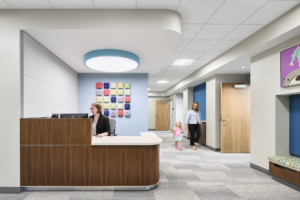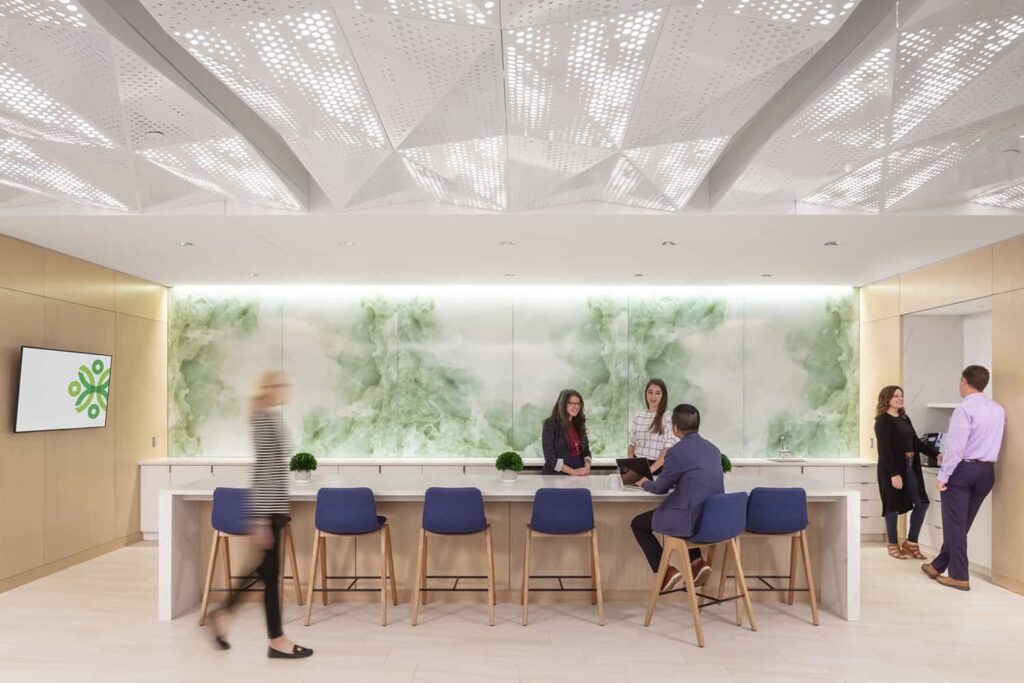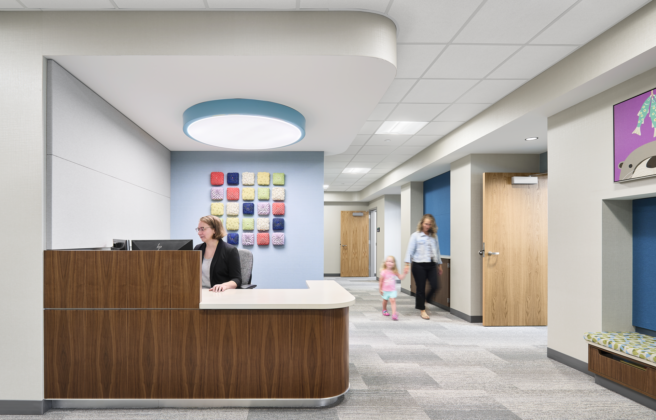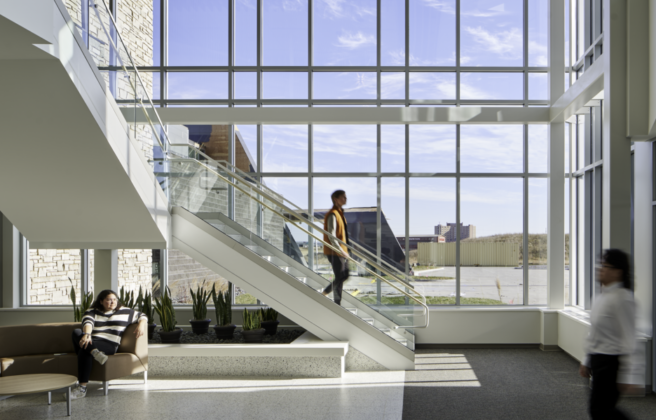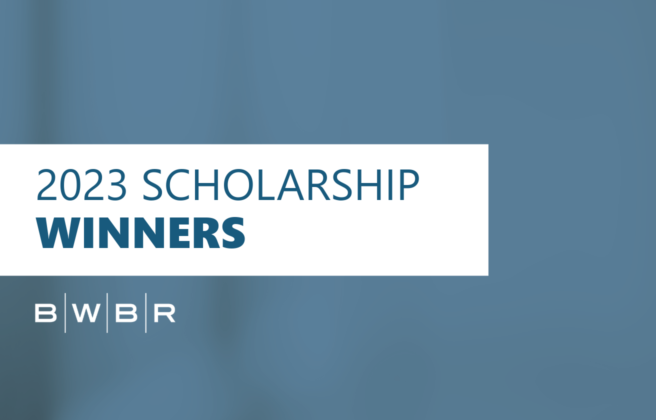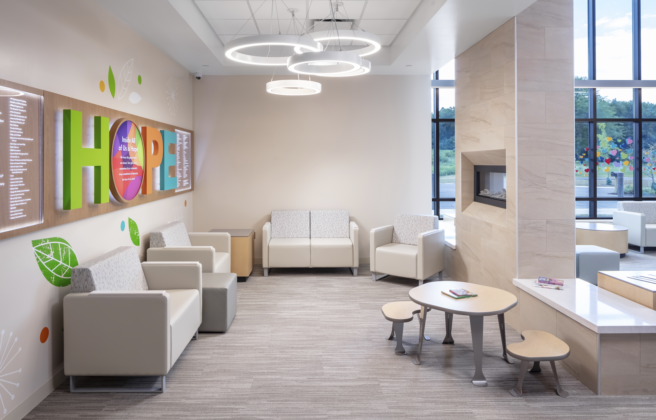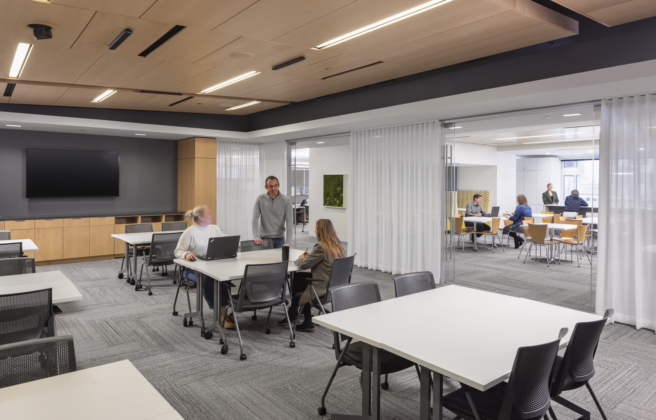For organizations that pivoted to remote work in 2020, the disruption forced a very quick transition to a work from home model. Now, looking ahead to fall 2021, they are taking a variety of approaches to returning employees and operations to the physical office, with many organizations embracing a hybrid working model. Unlike the abrupt pivot to remote working, returning to an office or launching a hybrid work model is done best with thorough intention and planning.
Jennifer Stukenberg, NCIDQ, LEED AP, WELL AP, a BWBR principal and workplace strategist with more than 25 years of experience, is a workplace design thought leader who helps organizations and companies use workplace strategy to improve worker experience, productivity, and wellbeing. In this two-part podcast, she details some approaches that organizations need to consider as they’re planning their future of work strategy.
Control, Flexibility, and Purpose
A recent Labor Department report stated that 4 million Americans quit their jobs in April. For Stukenberg, the pandemic has uncovered that compensation with benefits is not the only “carrot” that people want from their employers.
“When people are asked in the past year and a half what they really wanted and needed, many of them said time and flexibility to care for parents, for kids, and even just themselves with mental health issues,” said Stukenberg. Entry level workers took the time to reskill. Other workers decided to quit and follow a new passion. In the last year, burnout and its associated effects have become recurring topics of conversation.
Interestingly, another study from a company found that 5% of their workers had relocated since the start of the pandemic, and an additional 7% were thinking about it. This likely means that companies are going to have to offer more than just compensation to retain and to recruit workers.
Beyond the flexibility of relocating while continuing to work remotely, there is evidence to suggest that people are working remotely while traveling for extended periods of time, or even rethinking what they want out of their jobs – especially women and people with families, who represent some of the groups that were most impacted by the pandemic. People who used to work well over 40 hours every week are re-evaluating and finding that, despite earning a decent salary or good benefits, it’s not the work style they want to do anymore.
“People are making a choice about how and where they want to live, and that really is a benefit to us as a society as a whole, rather than just a problem that we need to fix as employers and companies… in the end it’s going to make for better employees.”
Jennifer Stukenberg
In general, though, people seem to want what they’ve always wanted: the feeling of belonging to something greater; to have meaning and purpose come out of their daily actions; and to feel successful, trusted, and valued, wherever they are.
Routine
On nearly the opposite side of the spectrum, employees are requesting routine. Studies show that routines reduce stress and help with sleep patterns. Stukenberg said, “Obviously, in a routine, you use the best use of your time, you are more effective. Even creativity is increased with routine.”
Stukenberg referenced how many creative professions like writers and artists are examples of people who benefit from routine, explaining that, “that routine, that practice – that leads to creativity. It also allows your unconscious mind to…work on other things other than just managing the stress of making decisions.”
Employers can help their employees succeed through the power of routines. Some employees may benefit from set hours in a physical office, while others may do better by simply knowing when a manager is available for questions. The key is to work with and empower each employee to set their own purposeful routine, rather than forcing an assigned plan.
Connections (Without the Water Cooler)
One thing Stukenberg hears a lot of people talk about is that they miss the “water cooler moments.” Her response is usually to ask, “Who said that was the best way to develop staff and to connect?”
The proverbial water cooler moment is an informal, casual interaction that leads to connections between coworkers, and sometimes even generates breakthroughs and inspiration. However, this idea only works if all employees have equal access to the same water cooler. In the new hybrid work model, that most likely isn’t the case.
“We need to look beyond recreating just some of the past habits that we had, because that’s the way we did them, and really get to what are we trying to do? How are we trying to develop staff, and not only be intentional, but to be equitable, so that the systems that we create work for everybody?”
Jennifer Stukenberg
Since remote working started, many employees note that their work conversations have become very planned and intentional, which is good for time management but lacks serendipitous discoveries. They miss their personal connections and relationships, bumping into coworkers in the hallway, and asking about plans outside of the office – all of which help people collaborate more and work better as a team.
“This last year has reinforced the importance of social spaces, and the collaboration spaces that were frankly unheard of 10-20 years ago,” said Stukenberg. “When we see people returning back to the office, not only are we seeing CEOs…bringing technology and upgrading video capabilities, but then they’re looking at those social spaces, because that’s what is going to bring people back.
“[Employees] will come into the office and they want to recharge by connecting with people and collaborating. We’re going to see the shift to emphasis of the space being more on collaborative social spaces, and see a decrease in the overall percentage of those individual spaces. We’ll still have [the individual spaces]…there’ll just be fewer of them, and they will look different.”
Meanwhile, individual work has gotten more private – one reason why people across the board agree they love working at home. In more enclosed spaces, some employees can focus for hours without distraction, often due to a greater sense of control over their environment.
“Going back to the office is going to be somewhat of a shock to people,” said Stukenberg. “Many CEOs are predicting that virtual communication is going to be the new norm. It will be a rare occasion when you just pick up the phone and call. We need to plan our offices around not only visual distractions, but increasing the acoustical properties of the spaces. We’re spending a lot of time evaluating acoustical properties that used to be good, but no longer are going to work.”
Less Burnout
Burnout is a topic that seems to be repeated in every return to work conversation. Some have attributed it to struggling with work-life balance, others think that Zoom fatigue may be a factor. It’s important to ask each individual what they feel is causing their burnout, and then make a plan for change.
“Burnout is when you become so overwhelmed that you start not to care and have an inability to actually complete tasks. What’s interesting about burnout is many times it has nothing to do with the amount of hours that you work,” said Stukenberg. She likes to ask questions like, “Do you feel your purpose? Do you feel you are contributing, and you feel like you’re having those small wins? You’re getting reinforcement and recognition for what you do?”
Whether in the physical office or working remotely, employers will need to reinforce the organization’s purpose with what people do. Making sure that daily tasks have meaning in the workplace can be a powerful tool to remind people that they matter and bring purpose and belonging back to their lives.
What Do Post-Pandemic Employees Need to be Successful? is part one of a two-part podcast series. Part two dives deeper into how a hybrid work model can prevent burnout and better support the workers and workplace of the future. To talk to Jennifer Stukenberg about workplace strategy, email her at jstukenberg@bwbr.com.

